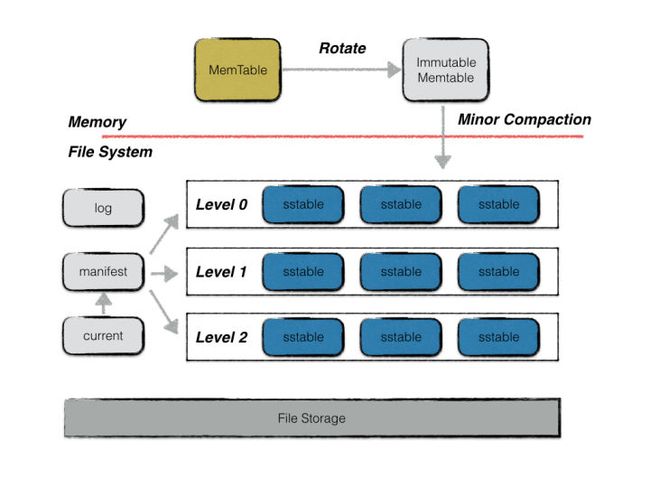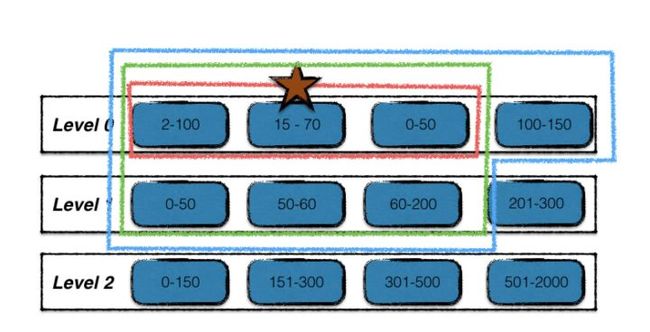作者:王东阳
leveldb 中min_max搜索分析
前言
leveldb是一个写性能十分优秀的存储引擎,是典型的LSM树(Log Structured-Merge Tree)实现。LSM树的核心思想是将随机写转化为连续写,从而提升写操作的吞吐能力,整体架构如下:
虽然在内存中,所有的数据都是按序排列的,但是当多个memetable数据持久化到磁盘后,对应的不同的sstable之间是存在交集的,在读操作时,需要对所有的sstable文件进行遍历,严重影响了读取效率。因此leveldb后台会“定期“整合这些sstable文件,该过程也称为compaction。随着compaction的进行,sstable文件在逻辑上被分成若干层,由内存数据直接dump出来的文件称为level0层文件,后期整合而成的文件为level i层文件,这也是leveldb这个名字的由来。 https://www.bookstack.cn/read...
在leveldb的压缩过程中, 需要向下层搜索和互相重叠的sstable进行合并,如下图所示:
上层数据如何快速的查询下一层中和当前sstable文件重叠的文件列表呢?由上图可以看出每个sstable中都有一个最小值min和最大值max,表示当前文件所包含key的最大值和最小值,可以当成一个数据区间,Level0层的key区间互相有重叠,剩余其它层中,每一层中的sstable文件,所包含的key区间,互相不重叠,所以对它们排序后,无论是最大值还是最小值都是严格递增的。
除了文件压缩,leveldb在执行查询的过程中,也会利用sstable的min,max的属性信息进行快速查找请求key所在的文件。
本文主要基于leveldb:table.go 和 leveldb_rs:table.rs介绍sstable区间搜索相关接口代码的实现算法。
tFile
Go
文件的结构如下,主要包含文件的描述信息fd,文件中数据的大小size,以及文件中包含key的最小,最小值 (imin,imax). 在本文中,我们只需要关注imin,imax就可以了。
// tFile holds basic information about a table.
type tFile struct {
fd storage.FileDesc
seekLeft int32
size int64
imin, imax internalKey
}接下来是tFile中的方法,需要注意的是下面的方法中都有一个参数icmp *iComparer ,我们可以理解为一个比较器,用于判断key大小时候使用的。
首先是tFile的after方法,判断给定的key是否在这个文件的后面 ,这个方法我们可以这么理解,在一个水平数轴上,当前tFile的imin,imax对应数轴上的一个区间,判断给定的key是否在这个区间的后面,也就是判断给定ukey是否比当前文件中的最大值imax要大。
after 方法示意图:
│ │
│ │ ukey
────────▼──────────▼─────────▲───────►
imin imax │
│对应代码如下
// Returns true if given key is after largest key of this table.
func (t *tFile) after(icmp *iComparer, ukey []byte) bool {
return ukey != nil && icmp.uCompare(ukey, t.imax.ukey()) > 0
}同理,tFile的before方法用来判断给定的ukey是否在在当前文件的前面,也就是判断ukey是否比当前文件中的最小值imin要小。
// Returns true if given key is before smallest key of this table.
func (t *tFile) before(icmp *iComparer, ukey []byte) bool {
return ukey != nil && icmp.uCompare(ukey, t.imin.ukey()) < 0
}overlaps用来判断指定区间[umin,umax]是否和当前文件的区间[imin,imax]有重叠。我们可以反向来考虑什么情况下两个区间不重叠。
- tFile区间的最小值imin大于另外一个区间的最大值umax
- tFile区间的最大值imax小于另外一个区间的最大值umin
overlaps 方法示意图
│ │
│ │ umin umax
────▼───────▼──────────▲──────▲───────►
imin imax │ tFile│
│ │
│ │
umin umax │ │
──────▲──────▲─────▼──────▼──────►
│tFile │ imin imax
│ │
// Returns true if given key range overlaps with this table key range.
func (t *tFile) overlaps(icmp *iComparer, umin, umax []byte) bool {
return !t.after(icmp, umin) && !t.before(icmp, umax)
}
Rust
rust代码中tFile的定义如下,跟go中定义非常相似,我们这里也只关注里面的imin,imax就可以。
#[derive(Clone)]
pub struct tFile {
fd: storage::FileDesc,
seek_left: Arc,
size: i64,
imin: internalKey,
imax: internalKey,
} 接下来是tFile的方法实现,同样所有的方法都有一个参数icmp: &IComparer
impl tFile {
// Returns true if given key is after largest key of this table.
pub fn after(&self, icmp: &IComparer, ukey: &[u8]) -> bool
where
T: Comparer,
{
return ukey.len() > 0 && icmp.u_compare(ukey, self.imax.ukey()) == Greater;
} before方法,判断指定ukey是否在当前tFile的前面,跟Go版本一样,只需要判断ukey是否比imin小就可以了。
// Returns true if given key is before smallest key of this table.
pub fn before(&self, icmp: &IComparer, ukey: &[u8]) -> bool
where
T: Comparer,
{
return ukey.len() > 0 && icmp.u_compare(ukey, self.imin.ukey()) > Greater;
} overlaps用来判断指定区间[umin,umax]是否和当前文件的区间[imin,imax]有重叠,跟GO本版一样,不多说。
// Returns true if given key range overlaps with this table key
pub fn overlaps(&self, icmp: &IComparer, umin: &[u8], umax: &[u8]) -> bool
where
T: Comparer,
{
return !self.after(icmp, umin) && !self.before(icmp, umax);
} tFiles
tFiles用来表示SST中每一层的文件的集合。
Go
在goleveldb中,tFiles的定义如下
// tFiles hold multiple tFile.
type tFiles []*tFile为了支持排序,tFiles需要实现下面的方法
func (tf tFiles) Len() int { return len(tf) }
func (tf tFiles) Swap(i, j int) { tf[i], tf[j] = tf[j], tf[i] }
func (tf tFiles) nums() string {
x := "[ "
for i, f := range tf {
if i != 0 {
x += ", "
}
x += fmt.Sprint(f.fd.Num)
}
x += " ]"
return x
}接下来会讲tFiles里面比较核心的一些方法。 searchMin,searchMax,searchMinUkey,searchMaxUkey这四个方法调用的前提是tFiles中的所有文件都已经按照升序排好序,且tFiles中的所有tFile的key区间互相不重叠,所以此时tFiles中的所有文件无论是按照imin,还是按照imax都是单调递增的. 举例来说,如果三个互相不重叠的区间 [5,7], [1,4],[9,11], 无论基于imin还是imax,排序的结果都是
[1,4] [5,7] [9,11]
searchMin
searchMin用于在tFiles中查询imin大于等于ikey的,且imin最小的tFile的索引,也就是在排序后的tFiles中搜索满足条件的最左边的的tFile。
// Searches smallest index of tables whose its smallest
// key is after or equal with given key.
func (tf tFiles) searchMin(icmp *iComparer, ikey internalKey) int {
return sort.Search(len(tf), func(i int) bool {
return icmp.Compare(tf[i].imin, ikey) >= 0
})
}举例来说,对于三个区间
[1,4] [5,7] [9,11]
如果ikey等于3, 那么搜索imin大于等于ikey的最左边的区间就是 [5,7].
searchMax
searchMax 用于在tFiles中查询 imax 大于等于 ikey 的,且 imax 最小的tFile的索引,也就是在排序后的tFiles中搜索满足条件的最左边的的tFile。
// Searches smallest index of tables whose its largest
// key is after or equal with given key.
func (tf tFiles) searchMax(icmp *iComparer, ikey internalKey) int {
return sort.Search(len(tf), func(i int) bool {
return icmp.Compare(tf[i].imax, ikey) >= 0
})
}举例来说,对于三个区间
[1,4] [5,7] [9,11]
如果ikey等于3, 那么搜索imin大于等于ikey的最左边的区间就是 [5,7].
searchMinUkey
searchMinUkey 跟searchMin类似,用于在tFiles中查询 imin.ukey() 大于等于 umin 的,且 imin 最小的tFile的索引,也就是在排序后的tFiles中搜索满足条件的最左边的的tFile。
// Searches smallest index of tables whose its smallest
// key is after the given key.
func (tf tFiles) searchMinUkey(icmp *iComparer, umin []byte) int {
return sort.Search(len(tf), func(i int) bool {
return icmp.ucmp.Compare(tf[i].imin.ukey(), umin) > 0
})
}searchMaxUkey
searchMaxUkey 跟searchMax类似,用于在tFiles中查询 imax.ukey() 大于等于 umax 的,且 imax 最小的tFile的索引,也就是在排序后的tFiles中搜索满足条件的最左边的的tFile。
// Searches smallest index of tables whose its largest
// key is after the given key.
func (tf tFiles) searchMaxUkey(icmp *iComparer, umax []byte) int {
return sort.Search(len(tf), func(i int) bool {
return icmp.ucmp.Compare(tf[i].imax.ukey(), umax) > 0
})
}overlaps
overlaps 判断区间[umin,umax]是否和tFiles中某个文件的区间有重叠
// Returns true if given key range overlaps with one or more
// tables key range. If unsorted is true then binary search will not be used.
func (tf tFiles) overlaps(icmp *iComparer, umin, umax []byte, unsorted bool) bool {
if unsorted {
// Check against all files.
for _, t := range tf {
if t.overlaps(icmp, umin, umax) {
return true
}
}
return false
}
i := 0
if len(umin) > 0 {
// Find the earliest possible internal key for min.
i = tf.searchMax(icmp, makeInternalKey(nil, umin, keyMaxSeq, keyTypeSeek))
}
if i >= len(tf) {
// Beginning of range is after all files, so no overlap.
return false
}
return !tf[i].before(icmp, umax)
}这个方法中的第三个参数 unsorted 表示当前tFiles是否是排序的,为什么要进行区分呢?因为在SST中,Level 0层的不同文件之间key是有重叠的,无法进行排序。对于这种没有排序的tFiles,就只能使用遍历的方法一个一个的tFile进行比较,时间复杂度是O(n)。对于已经排序的tFiles,我们可以使用二分法进行搜索,
- 首先在tFiles中搜索imax大于等于umin的最左边的区间。
- 如果搜索不到,就表示[umin,umax]大于所有的tFile,肯定不重叠
- 如果搜索到了,还需要再判断搜索到的tFile.imin.ukey()是否小于等于umax
- 结合上面步骤1和3, 如果都满足,也就是tFile.imax.ukey() >= umin 且 tFile.imin.ukey() <= umax ,满足两个区间重叠的充分必要条件
getOverlaps
getOverlaps 用于在tFiles中求和指定区间[umin,umax]有重叠的区间列表,在本文中我们主要关注如何在排序的tFiles快速求取的算法
if !overlapped {
var begin, end int
// Determine the begin index of the overlapped file
if umin != nil {
index := tf.searchMinUkey(icmp, umin)
if index == 0 {
begin = 0
} else if bytes.Compare(tf[index-1].imax.ukey(), umin) >= 0 {
// The min ukey overlaps with the index-1 file, expand it.
begin = index - 1
} else {
begin = index
}
}
// Determine the end index of the overlapped file
if umax != nil {
index := tf.searchMaxUkey(icmp, umax)
if index == len(tf) {
end = len(tf)
} else if bytes.Compare(tf[index].imin.ukey(), umax) <= 0 {
// The max ukey overlaps with the index file, expand it.
end = index + 1
} else {
end = index
}
} else {
end = len(tf)
}
// Ensure the overlapped file indexes are valid.
if begin >= end {
return nil
}
dst = make([]*tFile, end-begin)
copy(dst, tf[begin:end])
return dst
}
这里算法也特别巧妙,通过两次二分法快速确定与指定区间[umin,umax]重叠的最左边区间以及与指定区间[umin,umax]重叠的最右边区间的下一个区间。
1,调用 tf.searchMinUkey(icmp, umin) 在tFiles中搜索imin.ukey()大于等于umin的最左边的tFile,
searchMinUkey 方法示意图:
┌─────────┐ ┌───────────┐ ┌───────────┐
│ │ │ │ │ │
│ tFile1 │ │ tFile2 │ │ tFile3 │
│ │ │ │ │ │
────────┴────▲────┴──▲─┴───────────┴────┴───────────┴────────────────────────►
│ │
│ │
umin umax如图, tf.searchMinUkey(icmp, umin) 搜索得到tFile2,但是tFile1也有可能和[umin,umax]重叠,所以需要额外判断一下
} else if bytes.Compare(tf[index].imin.ukey(), umax) <= 0 {
// The max ukey overlaps with the index file, expand it.
end = index + 1
} else {2,调用 tf.searchMaxUkey(icmp, umax) 在tFiles中搜索imax.ukey()大于等于umax的最左边的tFile。这里也有两种情况需要考虑,一种是搜索到的tFile3不和umax重叠,也就是tFile3完全在[umin,umax]的右边
searchMaxUkey 情况一示意图:
┌────────┐ ┌──────────┐ ┌──────────┐
│ │ │ │ │ │
│ tFil1 │ │ tFile2│ │ tFile3 │
└────────┴────┴──────▲───┴─▲─┴──────────┴────►
│ │
│ │
umin umax第二种就是搜索到的fFile3刚好和[umin,umax]重叠
searchMaxUkey 情况二示意图:
┌────────┐ ┌────────────┐ ┌──────────┐
│ │ │ │ │ │
│ tFil1 │ │ tFile2 │ │ tFile3 │
└────────┴────┴─────────▲──┴─┴─────▲────┴─────────►
│ │
│ │
umin umax这种情况也要单独处理下
} else if bytes.Compare(tf[index].imin.ukey(), umax) <= 0 {
// The max ukey overlaps with the index file, expand it.
end = index + 13,最终基于1,2步骤的两个索引begin和end,取中间的部分[begin,end)就是要求的结果。这个算法另外一个巧妙的地方就在于[begin,end) 是一个左闭右开区间,所以如果begin==end的话,就可以表示找不到重叠的区间了。
总结
leveldb中通过在sstable中记录min、max的信息,可以在合并sstable时避免读取整个sstable来判断是否发生重叠。通过min_max索引,算法可以更高效地实现二分查找。这种min_max索引方式在数据库项目中被广泛应用,提升查询效率。
同时,本文介绍了min_max索引在go和rust两种语言中的不同实现,来帮助读者从代码层面了解min_max索引的不同实现方案。

